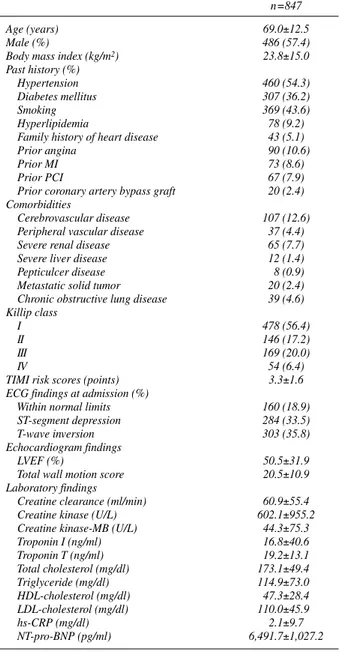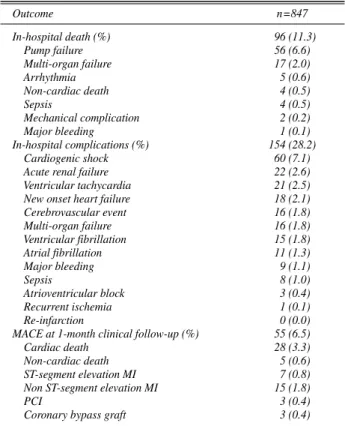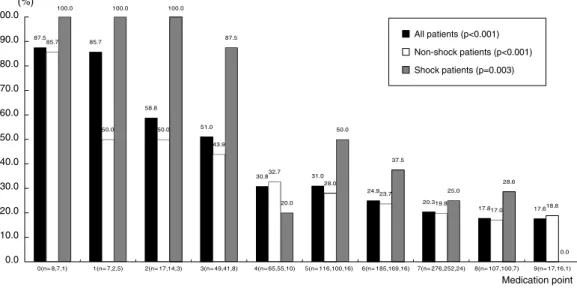he syndrome of non ST-segment elevation myocar- dial infarction (NSTEMI) accounts for much of the morbidity and mortality of cardiovascular disease.
1It is well known that percutaneous coronary intervention (PCI) is a most effective treatment of acute NSTEMI for restoring blood flow within the culprit artery.
2Recent studies indicate that a routine invasive approach for high-risk pa- tients with NSTEMI yields improved outcomes compared with a conservative approach.
3,4However, there are many patients who can not undergo PCI because of poor general health (eg, severe renal or liver disease, gastrointestinal bleeding, malignant neoplasm, chronic obstructive lung disease) or admission to a facility that cannot perform PCI.
In addition, NSTEMI can occur after episodes of hypoten- sion, severe sepsis or anemia in critical care patients with
acute non-cardiac illness.
5,6In these situations appropriate conservative treatment is important.
We conducted the present study to assess the impact of pharmacological treatment, with a focus on its influence on short-term clinical outcome in NSTEMI patients enrolled in the Korea Acute Myocardial Infarction Registry (KAMIR).
Methods
Study Population and Study Design
The KAMIR is a prospective, multicenter, observational registry designed to examine current epidemiology, in-hos- pital management and outcome of patients with acute myo- cardial infarction (MI) in Korea. A total of 50 university or community hospitals that are high-volume centers with facilities for PCI and on-site cardiac surgery were included in the KAMIR, which included 12,867 patients with acute MI admitted between November 2005 and August 2007. Of these, 4,059 patients with a final diagnosis of NSTEMI were enrolled in the present study and 1,124 patients (69.2±12.5 years, 637 males) were treated conservatively.
Eligible patients had to have all 3 of the following: symp- toms of ischemia that were increasing or occurred at rest, an elevated cardiac troponin I level (≥2.0 ng/ml) or creatine kinase-MB (19 U/L, exceeding twice the upper limit of normal); and ischemic changes as assessed by electrocar- diography (ECG) (defined as ST-segment depression or
(Received January 28, 2008; revised manuscript received April 9, 2008; accepted April 16, 2008)
Heart Center of Chonnam National University Hospital, Gwangju, Republic of Korea
*Korea Acute Myocardial infarction Registry (KAMIR) Study Group of Korean Circulation Society members are listed in Appendix 1.
Mailing address: Young Keun Ahn, MD, PhD, FACC, FSCAI, As- sistant Professor, Director of Cardiovascular Medicine, Heart Center of Chonnam National University Hospital, 8 Hak Dong, Dong Ku, Gwangju 501-757, Republic of Korea. E-mail: cecilyk@hanmail.net All rights are reserved to the Japanese Circulation Society. For per- missions, please e-mail: cj@j-circ.or.jp
Intensive Pharmacologic Treatment in Patients With Acute Non ST-Segment Elevation Myocardial Infarction Who
Did Not Undergo Percutaneous Coronary Intervention
Hae Chang Jeong, MD; Young Keun Ahn, MD; Myung Ho Jeong; Shung Chull Chae; Jong Hyun Kim;
In Whan Seong; Young Jo Kim; Seung Ho Hur; Dong Hoon Choi; Taek Jong Hong; Jung Han Yoon;
Jae Young Rhew; Jei Keon Chae; Doo Il Kim; In Ho Chae; Bon Kwon Koo; Byung Ok Kim;
Nae Hee Lee; Jin Yong Hwang; Seok Kyu Oh; Myeong Chan Cho; Kee Sik Kim;
Kyoung Tae Jeong; Myoung Yong Lee; Chong Jin Kim; Wook Sung Chung and other Korea Acute Myocardial Infarction Registry Investigators*
Background The aim of this study was to assess the impact of more aggressive pharmacological treatment on short-term clinical outcomes in patients with acute non ST-segment elevation myocardial infarction (NSTEMI) who do not undergo percutaneous coronary intervention (PCI).
Methods and Results The 924 NSTEMI patients treated with early conservative strategy (69.2±12.5 years, 637 males) in 50 hospitals that were high-volume centers with facilities for primary PCI were recruited to the Korean Acute Myocardial Infarction Registry (KAMIR) from November 2005 to August 2007. For all patients, the pharmacotherapy index based on the use of drugs during hospital stay was assessed (range of points 0–10).
Primary endpoint was the combined in-hospital mortality and morbidity and major adverse cardiac events during 1 month of clinical follow-up. Of the patients, data from 847 who were followed-up for 1 month after discharge were analyzed. The rate of the primary endpoint decreased with an increase of the pharmacotherapy index and this result was similar in the low- and high-risk groups. In the multivariate analysis, low pharmacotherapy index (≤4 points) was an independent predictor of the primary endpoint.
Conclusions More intensive pharmacological treatment may improve short-term clinical outcomes in acute NSETMI patients who do not undergo PCI. (Circ J 2008; 72: 1403 – 1409)
Key Words: Drugs; Myocardial infarction; Non ST-segment elevation; Prognosis
T
1404
T-wave inversion ≥0.2 mV in 2 contiguous leads).
We analyzed baseline demographic and clinical charac- teristics, relevant laboratory results, pharmacotherapy, mor- tality and morbidity during hospital stay. Killip class was evaluated at admission and the Thrombolysis In Myocardial Infarction (TIMI) risk score was calculated according to the guideline of Antman et al
7for each patient. ECG and echo- cardiography were performed in all patients. Major adverse cardiac events (MACE) during a 1-month clinical follow-up were evaluated. All data were recorded on a standardized, electronic, web page-based case report form (http://www.
kamir.or.kr).
Cardiogenic shock was defined as reduced blood pres- sure (systolic blood pressure <90 mmHg or decrease in mean arterial pressure >30 mmHg) and/or low urine output
(<0.5 ml· kg
–1· h
–1), with a pulse rate >60 beats/min with or without evidence of organ congestion.
8Baseline creatinine clearance was calculated using the Cockcroft – Gault formu- la taking into account age, sex and body weight.
9Renal in- sufficiency was defined as creatinine clearance <60 ml/min.
Pharmacological Treatment
For all patients, the pharmacotherapy index based on the use of pharmacological treatment regimens according to the attending doctor’s decision during hospital stay was assessed. Each patient received 1 point for each of the fol- lowing guideline-recommended drugs: aspirin, clopidogrel, platelet glycoprotein IIb/IIIa inhibitor, low-molecular- weight or unfractionated heparin, β-blocker, angiotensin- converting enzyme inhibitor (ACEI)/angiotensin II receptor blocker (ARB), statin, cilostazol, nicorandil and nitrate; the range of points was from 0 to 10. The drugs were adminis- tered intravenously for unfractionated heparin and glyco- protein IIb/IIIa inhibitor, subcutaneously for low-molecular- weight heparin, and orally for the others.
Primary Endpoint
The primary endpoint was a composite of in-hospital death, complications, and MACE in the 1-month clinical follow-up. Death was defined as death from pump failure, mechanical complication (rupture of free wall, ventricular septal defect, mitral regurgitation etc), arrhythmia, sepsis, multi-organ failure, major bleeding, and non-cardiac origin.
Cardiogenic shock, ventricular tachycardia and fibrillation (needed for anti-arrhythmic agent and/or defibrillation), atrioventricular blocker (needed for pacemaker), recurrent ischemia and MI, cerebrovascular accident, major bleeding, acute renal failure, multi-organ failure and sepsis were included as complications. MACE was defined as cardiac death, non-cardiac-death, MI, repeat PCI (target lesion or non-target lesion revascularization), and coronary artery bypass grafting.
Statistical Analysis
The SPSS for Windows, version 15.0 (Chicago, IL, USA) was used for all analyses. Continuous variables are presented as the mean value ± SD; comparisons were con- ducted by Student’s t-test. Discrete variables are presented as percentages and relative frequencies; comparisons were made using chi-square statistics or Fisher’s exact test as appropriate. Subgroups of high risk and low risk according to TIMI risk score, levels of high-sensitivity C-reactive pro- tein (hs-CRP) and N-terminal pro-brain natriuretic peptide (NT-pro-BNP), and age were analyzed to minimize the selection bias. Logistic regression analysis was performed to identify the independent predictors of the primary end- point. The 95% confidence interval for the relative risk was calculated using standard errors from the Kaplan-Meier curve. A p-value <0.05 was considered statistically signifi- cant.
Results
Study Population
Baseline characteristics and hemodynamics of the 847 patients who were followed for 1 month after discharge are shown in Table 1. The reasons why the patients could not undergo PCI were as follows: 766 (90.4%) were poor can- didates for coronary angiography or PCI, 42 (4.9%) had failed PCI, 39 (4.6%) refused PCI, 91 (10.7%) were in
n=847
Age (years) 69.0±12.5
Male (%) 486 (57.4)
Body mass index (kg/m
2) 23.8±15.0
Past history (%)
Hypertension 460 (54.3)
Diabetes mellitus 307 (36.2)
Smoking 369 (43.6)
Hyperlipidemia 78 (9.2)
Family history of heart disease 43 (5.1)
Prior angina 90 (10.6)
Prior MI 73 (8.6)
Prior PCI 67 (7.9)
Prior coronary artery bypass graft 20 (2.4) Comorbidities
Cerebrovascular disease 107 (12.6)
Peripheral vascular disease 37 (4.4)
Severe renal disease 65 (7.7)
Severe liver disease 12 (1.4)
Pepticulcer disease 8 (0.9)
Metastatic solid tumor 20 (2.4)
Chronic obstructive lung disease 39 (4.6) Killip class
I 478 (56.4)
II 146 (17.2)
III 169 (20.0)
IV 54 (6.4)
TIMI risk scores (points) 3.3±1.6
ECG findings at admission (%)
Within normal limits 160 (18.9)
ST-segment depression 284 (33.5)
T-wave inversion 303 (35.8)
Echocardiogram findings
LVEF (%) 50.5±31.9
Total wall motion score 20.5±10.9
Laboratory findings
Creatine clearance (ml/min) 60.9±55.4
Creatine kinase (U/L) 602.1±955.2
Creatine kinase-MB (U/L) 44.3±75.3
Troponin I (ng/ml) 16.8±40.6
Troponin T (ng/ml) 19.2±13.1
Total cholesterol (mg/dl) 173.1±49.4
Triglyceride (mg/dl) 114.9±73.0
HDL-cholesterol (mg/dl) 47.3±28.4
LDL-cholesterol (mg/dl) 110.0±45.9
hs-CRP (mg/dl) 2.1±9.7
NT-pro-BNP (pg/ml) 6,491.7±1,027.2
Table 1 Baseline Clinical Characteristics and Hemodynamics of Patients Given Conservative Treatment
MI, myocardial infarction; PCI, percutaneous coronary intervention; TIMI,
Thrombolysis In Myocardial Infarction; LVEF, left ventricular ejection
fraction; HDL, high-density lipoprotein; LDL, low-density lipoprotein; hs-
CRP, high-sensitive C-reactive protein; NT-pro-BNP, N-terminal pro-brain
natriuretic peptide.
cardiogenic shock and 223 (27.3%) had a high Killip class (≥III).
Pharmacological Treatment
The mean pharmacotherapy index was 6.0±1.7. Most pa- tients (32.6%) had 7 points (0 points: 0.9%; 1 point: 0.8%;
2 points: 2.0%; 3 points: 5.8%; 4 points: 7.7%; 5 points:
13.7%; 6 points: 21.8%; 7 points: 32.6%; 8 points: 12.6%;
9 points: 2.0%; 10 points: 0.0%). Patients with lower phar- macotherapy index values were more likely to have cardio- genic shock (5.3±2.0 with shock patients vs 6.1±1.6 with non-shock patients, p<0.001). There was no significant dif- ference in the pharmacologic index according to the pres- ence of hypertension, diabetes or hyperlipidemia and no sig- nificant correlation with age, TIMI risk score, Killip class, ejection fraction or laboratory results.
Primary Endpoints
Total in-hospital mortality and morbidity for the 1,124 patients was 15.8% and total 1-month MACE, including in-hospital mortality and morbidity, was 26.9%. Primary endpoints based on the drugs used during hospital stay are presented in Fig 1. In the univariate analysis, use of aspirin, clopidogrel, ACEI/ARB,β-blocker, statins, nitrate, heparin, nicorandil, and cilostazol led to a significant reduction of in- hospital death and complications (odds ratio=0.132, 0.392, 0.359, 0.384, 0.638, 0.644, 0.643, 0.634, 0.548, respective- ly, p<0.001, <0.001, <0.001, <0.001, 0.005, 0.009, 0.019, 0.021, 0.046 respectively; Table 2).
Primary Endpoints in Subgroup Analysis
The primary endpoints decreased with an increase of the pharmacotherapy index (p<0.001). In the subgroup analysis, the primary endpoints were significantly higher in the car- diogenic shock group than in the non-shock group (44.0%
vs 24.9%, p<0.001). Higher pharmacologic index improved the clinical outcome in both the cardiogenic shock and non- shock group (p=0.003, <0.001, respectively) (Fig 2).
All patients were categorized into 3 groups according to TIMI risk score. A total of 37.4% were classified as low-
risk (0–2 points), 39.1% as intermediate-risk (3–4 points), and 23.5% as high-risk (5–7 points). The primary endpoints of each subgroup are presented in Fig 3. The tendency for the primary endpoints to decrease with the increase of the pharmacotherapy index were observed in all 3 risk groups (Fig 3) (p=0.015, 0.003, <0.001, respectively).
The patients were classified by the levels of hs-CRP and NT-pro-BNP. The primary endpoints decreasing with the in-
Rate of primary end point (%) Variable No (%) Odds ratio Treated patients Un-treated patients p
Aspirin 815(96.2) 205(25.2) 23(71.9) <0.001
Clopidogrel 750(88.5) 184(24.5) 44(45.4) <0.001
ACEI/ARB 697(82.3) 160(23.0) 68(45.3) <0.001
β-blocker 607(71.7) 129(21.3) 99(41.3) <0.001
Statin 565(66.7) 135(23.9) 93(33.0) 0.005
Nitrate 617(72.8) 151(24.5) 77(33.5) 0.009
LMWH/UFH 690(81.5) 174(25.2) 54(34.4) 0.019
Nicorandil 191(22.6) 39(20.4) 189(28.8) 0.021
Cilostazol 80(9.4) 14(17.5) 214(27.9) 0.046
Glycoprotein IIb/IIIa inhibitor 67(7.9) 17(25.4) 211(27.1) 0.766
0.0 0.5 1.0 1.5 2.0
0.132
0.392
0.359
0.384
0.638
0.644
0.634
0.548 0.643
0.917
Fig 1. Estimated rates and odd ratios of the composite primary endpoint according to pharmacologic treatment with each drug. ACEI, angiotensin-converting enzyme inhibitor; ARB, angiotensin II receptor blocker; LMWH, low-molecular- weight heparin; UFH, unfractionated heparin.
Outcome n=847
In-hospital death (%) 96 (11.3)
Pump failure 56 (6.6)
Multi-organ failure 17 (2.0)
Arrhythmia 5 (0.6)
Non-cardiac death 4 (0.5)
Sepsis 4 (0.5)
Mechanical complication 2 (0.2)
Major bleeding 1 (0.1)
In-hospital complications (%) 154 (28.2)
Cardiogenic shock 60 (7.1)
Acute renal failure 22 (2.6)
Ventricular tachycardia 21 (2.5)
New onset heart failure 18 (2.1)
Cerebrovascular event 16 (1.8)
Multi-organ failure 16 (1.8)
Ventricular fibrillation 15 (1.8)
Atrial fibrillation 11 (1.3)
Major bleeding 9 (1.1)
Sepsis 8 (1.0)
Atrioventricular block 3 (0.4)
Recurrent ischemia 1 (0.1)
Re-infarction 0 (0.0)
MACE at 1-month clinical follow-up (%) 55 (6.5)
Cardiac death 28 (3.3)
Non-cardiac death 5 (0.6)
ST-segment elevation MI 7 (0.8)
Non ST-segment elevation MI 15 (1.8)
PCI 3 (0.4)
Coronary bypass graft 3 (0.4)
Table 2 Cumulative Rates of the Composite Primary Endpoint
MACE, major adverse cardiac events. Other abbreviations see in Table 1.
1406
crease of pharmacotherapy index occurred in both the lower hs-CRP group (<0.875 mg/dl) and higher hs-CRP group (≥0.875 mg/dl) (p<0.001, 0.001, respectively) (Fig 4), and similarly in both the lower NT-pro-BNP (<1,018 pg/ml) and higher NT-pro-BNP group (≥1,018 pg/ml) (p=0.015, 0.002, respectively) (Fig 5).
Subgroups were analyzed according to age. Overall, the primary endpoint was 35.5% in the elderly group (≥75 years, n=318) and 21.7% in the non-elderly group (<75 years, n=529). The primary endpoint decreased with the increase of pharmacotherapy index in both the elderly and non-elder- ly groups (0 points: 100%, 86%; 1 point: 100%, 80%; 2 points: 80%, 50%; 3 points: 54%, 48%; 4 points: 46%, 24%;
5 points: 37%, 25%; 6 points: 36%, 20%; 7 points: 28%, 15%; 8 points: 26%, 14%; 9 points: 20%, 8%; p=0.038, p<
0.001, respectively).
Multivariate Analysis of In-Hospital Mortality and Morbidity
In the multivariate regression analysis, independent pre- dictors of in-hospital mortality and morbidity were high Killip score (≥II), low pharmacotherapy index (≤4 points),
high levels of NT-pro-BNP (≥1,018 pg/ml), high levels of hs-CRP (≥0.875 mg/dl), and high TIMI risk score (≥5 points) (p<0.001, p<0.001, p=0.011, p=0.013, p=0.033, respective- ly) (Table 3).
Discussion
Acute coronary syndrome (ACS) is categorized into un- stable angina, NSTEMI, and STEMI,
10and the most effec- tive treatment is revascularization using PCI.
11The majority of recent studies are focused on invasive revascularization therapy for the management of ACS,
12–14but in certain situa- tions appropriate medical treatment is also important. Our data support the benefit of more aggressive pharmacological treatment in patients with NSTEMI who do not or cannot undergo PCI. Regardless of the risk profile, the proposed pharmacotherapy index was shown to be an independent predictor of short-term clinical outcomes. For every unit in- crease in the pharmacotherapy index, the rate of incidence of the primary endpoint decreased. Even though patients with cardiogenic shock and in poor general condition might receive less pharmacologic treatment because of contra-
87.5 85.7
58.8
51.0
30.8 31.0
24.9
20.3
17.8 17.6
85.7
50.0 50.0
43.9
32.7
28.0
23.7
19.8
17.0 18.8
100.0 100.0 100.0
87.5
20.0
50.0
37.5
25.0
28.6
0.0
0.0 10.0 20.0 30.0 40.0 50.0 60.0 70.0 80.0 90.0 100.0
0(n= 8,7,1) 1(n= 7,2,5) 2(n= 17,14,3) 3(n= 49,41,8) 4(n= 65,55,10) 5(n= 116,100,16) 6(n= 185,169,16) 7(n= 276,252,24) 8(n= 107,100,7) 9(n= 17,16,1)
Medication point (%)
All patients (p<0.001) Non-shock patients (p<0.001) Shock patients (p=0.003)
Fig 2. Primary endpoint for the conservative pharmacotherapy index value for all, non-shock and shock patients.
(%)
80.0
75.0
50.0
46.1
25.9 24.4
14.8
12.1
5.3
0.0
100.0 100.0
75.0
51.9
42.3 43.5
27.5
23.4
16.2
20.0
100.0 100.0
80.0
66.7
50.0
48.2
34.3
19.7
15.6 14.3
0.0 10.0 20.0 30.0 40.0 50.0 60.0 70.0 80.0 90.0 100.0
0(n=5,1,2) 1(n=4,1,2) 2(n=4,8,5) 3(n=13,27,9) 4(n=27,26,12) 5(n=41,46,29) 6(n=81,69,35) 7(n=99,111,66) 8(n=38,37,32) 9(n=5,5,7)
Medication point Low risk patients (TIMI risk score 0~2) p<0.001
Moderate risk patients (TIMI risk score 3~4) p=0.003 High risk patients (TIMI risk score group 5~7) p=0.015
Fig 3. Primary endpoint according to the conservative pharmacotherapy index values for patients with high, moderate,
and low Thrombolysis In Myocardial Infarction (TIMI) risk score.
indications of each drug, in the present study the results were similar for the non-shock and low-risk groups, as well as for the shock and high-risk groups.
Few clinical studies have investigated pharmacologic treatment for NSTEMI patients. Our results were compara- ble with those in previously reported clinical trials.
3,4,15The Malopolska Registry of Acute Coronary Syndromes (MRACS) registry data demonstrated that more aggressive pharmacological treatment may improve clinical outcome in patients with NSTE ACSs treated conservatively.
15The CRUSADE (Can Rapid Risk Stratification of Unstable Angina Patients Suppress Adverse Outcomes with Early Implementation of the ACC/AHA Guidelines) registry data demonstrated that patients who presented with NSTEMI
and did not receive guideline-recommended therapies had a higher mortality rate.
3Similarly, Gulati et al have shown that compliance with recommended guidelines results in fewer adverse cardiac events, independent of the risk strati- fication model.
4There are different points between the present study and previous trials. First, the previous trials (especially MRACS registry study) were conducted without on-site invasive facilities and the study populations were not transferred to other hospitals for invasive treatment. Therefore, there are many selection biases of enrollment in the study group. Pa- tients who did not require PCI because of low disease severity or who could not be transferred to another hospital because of poor general condition were likely to be enrolled.
(%)
66.7
57.1
42.1
16.7 27.5
16.1
7.8 9.1
0.0 100.0
75.0
66.7
43.5 39.5
36.7 31.0
25.0 42.9 100.0 100.0
0.0 10.0 20.0 30.0 40.0 50.0 60.0 70.0 80.0 90.0 100.0
0 1 2 3 4 5 6 7 8 9
Medication point Lower hs-CRP group (<0.875 mg/dl) p<0.001 Higher hs-CRP group (>0.875 mg/dl) p<0.001
(%)
0.0 25.0
16.7 14.3
8.7
4.8 3.6
14.3
100.0 100.0
62.5
43.8 37.8
32.9
28.4 27.5
20.0 100.0
0.0 10.0 20.0 30.0 40.0 50.0 60.0 70.0 80.0 90.0 100.0
0 1 2 3 4 5 6 7 8 9
Medication point Lower NT-pro-BNP group (<1,018 pg/ml) p=0.015 Higher NT-pro-BNP group (>1,018 pg/ml) p=0.002



